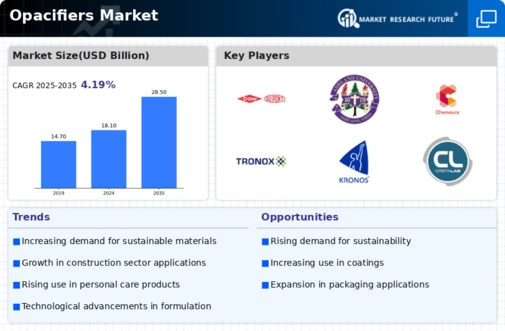Top Industry Leaders in the Opacifiers Market

Opacifiers, the unsung heroes of the materials world, play a crucial role in transforming transparent materials into opaque wonders. From the dazzling white of your printer paper to the vibrant colors of your favorite plastic toys, opacifiers work tirelessly behind the scenes, adding depth and vibrancy to our everyday lives. But the opacifiers market is far from a transparent landscape. It's a dynamic arena where established giants and innovative startups clash in a battle for market share, employing diverse strategies and riding the waves of evolving trends.
Market Share: A Multifaceted Puzzle
Several factors influence who gets the lion's share in this intricate market:
-
Opacifier Type: Titanium dioxide (TiO₂) reigns supreme, accounting for over 80% of the market due to its affordability and effectiveness. However, alternative opacifiers like zinc oxide and opaque polymers are gaining traction due to concerns about TiO₂'s environmental impact and potential health risks. -
Application Scope: Opacifiers find applications in a wide range of industries, including paints and coatings, plastics, paper, personal care products, and ceramics. Each industry has its specific needs, influencing the type and amount of opacifier used. -
Geographical Distribution: Asia Pacific leads the charge, driven by rapid industrialization and a growing demand for consumer goods. However, Europe and North America remain significant players, with mature markets and high demand for specialized opacifiers. -
Environmental Regulations: Stringent regulations on TiO₂ usage and concerns about its environmental footprint are driving the development and adoption of alternative opacifiers. -
Player Strategies: From chemical giants like BASF and DuPont to niche players specializing in green alternatives, the market boasts a diverse range of competitors. Their strategies range from product diversification and technological advancements to sustainability initiatives and strategic partnerships.
Sticky Strategies: Securing a Foothold in the Market
Players in the opacifiers market are wielding their chemical expertise to secure their share:
-
Product Innovation: Developing new opacifiers with improved performance, reduced environmental impact, and enhanced safety profiles caters to evolving demands and differentiates players from the competition. -
Sustainability Focus: Highlighting the eco-friendly aspects of alternative opacifiers, such as their biodegradability and lower carbon footprint, resonates with environmentally conscious consumers and aligns with green regulations. -
Technological Advancements: Implementing advanced nanotechnology and coating technologies leads to more efficient opacifiers that require less material and offer superior performance. -
Market Expansion: Entering new geographical markets or expanding existing footprints in high-growth regions like Asia Pacific and Latin America fuels market share growth. -
Strategic Partnerships: Collaborating with raw material suppliers, research institutions, and application-specific industries fosters innovation and opens up new avenues for product development and market reach.
Key Players:
- DowDuPont (US)
- Arkema (France)
- Ashland (US)
- TAYCA (Japan)
- The Chemours Company (US)
- Tronox Limited (US)
- KRONOS Worldwide Inc. (US)
- CRISTAL (Saudi Arabia)
- Alkane Resources Ltd (Australia)
- En-Tech Polymer Co. Ltd. (South Korea)
- Venator Materials PLC (UK)
Recent Developments:
August 2023: BASF, a leading chemical manufacturer, announces plans to invest in a new production facility for its sustainable opacifier alternative, Catanium™.
September 2023: The American Coatings Association releases a report highlighting the growing importance of opacifiers in energy-efficient paints and coatings.
October 2023: Lanxess, a specialty chemicals company, unveils a new line of bio-based opacifiers made from corn starch, offering a sustainable alternative for the plastics industry.
November 2023: Researchers at MIT develop a new type of opacifier made from recycled glass, potentially paving the way for a circular economy in the opacifiers market.
December 2023: The World Green Building Council recognizes a project that utilizes innovative opacifiers in high-performance windows, showcasing the potential of these materials for sustainable construction.










